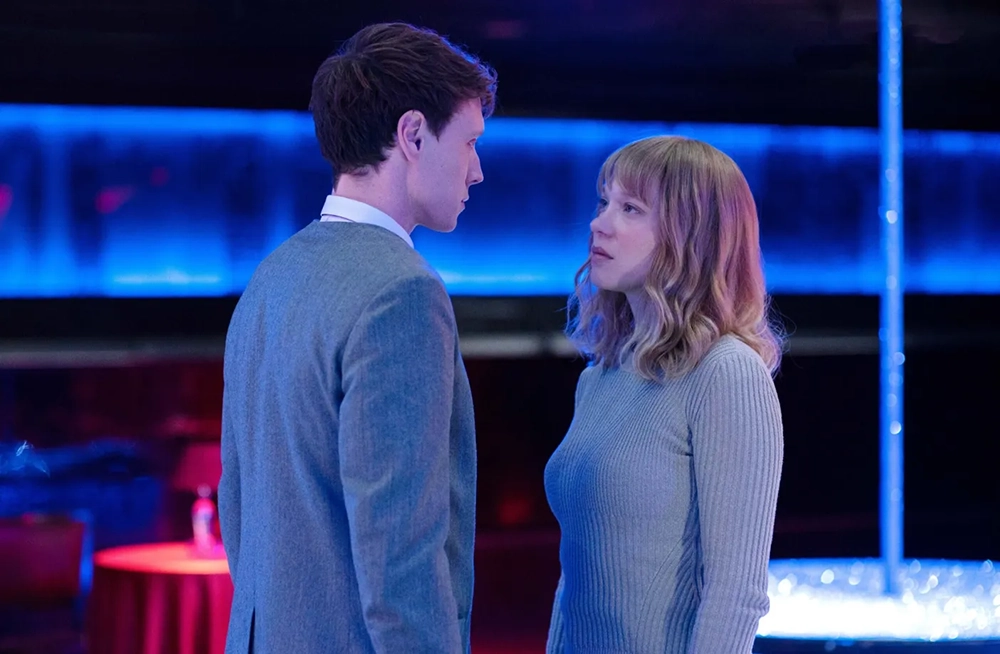With “The Beast,” Bertrand Bonello concocts a riveting and piercing Matryoshka doll-like exploration of the erasure of emotions amidst artificial intelligence with his loose adaptation of Henry James’s novel, “The Beast in the Jungle.” The road may occasionally be bumpy as it crosses genres and uses repetition as a narrative gadget. Yet, the film leaves an impact with its questions about the essence of existence and what makes us humans.
Even though he began his career on a quite pretentious and self-indulgent foot with films like “The Pornographer” and “House of Tolerance,” French filmmaker Bertrand Bonello has churned out a compelling filmography as of late. What I admire about him is that he never wants to make the same film or showcase some of his tricks twice – tonally, stylistically, and narrative-wise. And with this evolution of his directorial panache and vision, which is richer and far more engaging than his work previous to “Nocturama” back in 2016, it makes Bonello look like he’s on his way to becoming one of the most creative and fascinating voices to follow in French cinema. When he clears his mind and shifts his focus from indulgence to reinvention, you get great pieces of work like 2019’s “Zombi Child” and last year’s love letter to his daughter, “Coma.”
Bertrand Bonello’s Cloud Atlas-like Project
He has the gifts to do something that will impress the world. And the time has come. Now, the French filmmaker is once again playing with genres he has never dealt with before in science fiction while adding some romance and dramatic sensibilities. Titled “The Beast,” Bonello strips apart (and coincidentally forges back again) the emotional tangibility of his characters to create an odd yet intriguing experience that’s carried by the director’s ambitiousness—similar to when the Wachowskis made “Cloud Atlas,” although without the multi-million-dollar scale and canvas—and the leading duo of George MacKay and Léa Seydoux. Even if his latest is unconventional and idiosyncratic, causing many viewers to tune out (especially in the first hour), I found it a vibrant big swing that nobody could have concocted and structured in a polished manner. Yet, Bonello found a way to do so.
So, hold on tight because the road might be bumpy. However, it is all enticing, more than his previous pictures—ending as his best. Loosely based on Henry James’ novella, “The Beast of the Jungle,” Bonello’s film begins with Gabrielle (played by one of the most magnetic screen presences of modern cinema, Léa Seydoux) in 2044. In that version of the future, people can have their emotions removed from one’s essence. The main reason people do so at that point in time is because they are seen as threats to humanity. What’s the leading cause? They impede employment because of the rise of artificial intelligence. Unemployment has reached a bewildering sixty-seven percent in this new world. Gabrielle has decided to partake in this array of experiments that eliminate those feelings, emotions, and sensations in your soul. What makes her human slowly disappears, turning her into a glacial succubus.

“The Beast” tunes itself into a distorted picture that blends as many genres (sci-fi, romance, mystery, drama) and tropes that accompany each one of them as the characters question the world they live in and if there’s the necessity for love at a time like that. The test begins. The machine sends Gabrielle back in time to explore her past lives. Bonello’s film doesn’t meddle with the concept of inyun, unlike Celine Song’s marvelous debut, “Past Lives.” But it reflects on the effects that time has on us all, both physically and mentally, and the various possibilities that might have happened throughout our rocky courses in life. One of the first ones we see is set back in 1910, where she meets an English gentleman named Louis (George MacKay) at a fancy party in Paris with beautiful gowns and lavish suits.
Fractured Timelines and Broken Hearts
This isn’t their first meeting, as Gabrielle is later told. He also mentions that she spoke of a significant threat lingering around like a cloud above their heads. She doesn’t have any recollection of such an encounter with Louis. Yet their chemistry together at that point in time slowly builds into a romantic affair. What’s strange in these circumstances is that a bird is always present when these two souls connect with one another. It happened in 1910, later in 2014, and thirty years later when they both decided to have their emotions removed simultaneously. Is fate tying them together, later separating each other when things are about to reach a more intimate level? Is the universe out to get them? The Matryoshka doll effect that the film has over their romance seems to detail such manners.
The repetition of each is similar, yet visually (or in terms of genre) distinct. It even makes us think about the mundanity of life. One little change from your regular routine might be the saving grace or breaking point of your day or week. It leaves them confused and the audience more so to an enticing degree. Gabrielle might stay the same, but Louis is partaking in different roles each time (on one occasion, an incel and another a stalker). It’s a film that requires multiple viewings. We need time to peel all of the layers Bonello keeps secret in the shadows and amidst each timeline. They have to go through hell in order to bond. It reminds me of a myth-like procedure. Tragedy and omens haunt their daily lives as their paths continue to cross.
While its first act might have a more conventional flavoring, the rest of “The Beast” isn’t. It contains an array of playfulness and experimental artistry that we haven’t seen Bonello do visually or in that scope. This being a Bertrand Bonello film, his latest does contain some form of indulgence, primarily in the first act. But all of that is excusable for me since he managed to create something equally alienating (with a purpose, considering its theme of the dangers of artificial intelligence), conceptual, and psychologically intuitive. Right in the middle of it, a human element makes everything have a more profound impact on the viewer. It is more prevalent here more so than in his other works. The human component of “The Beast” is centered around three vital questions Bonello presents to us.

A World Without Emotions and The Fear of Love
What would you do if you had to get rid of your emotions? How would a world without such work? Are we ready to give up one of the primary things that makes us human? Answering those questions raises fascinating and uncomfortable conversations about the essence of life, as emotions are tied to memories. And those same memories—whether they are ones we hold dear or others we would like to forget—forge our identity, which later on serves to make a path for us to cross through the weeks, months, and years. We are left with absolutely nothing if you take all of that away. What would be the purpose of living if there’s no pain, laughter, joy, or even a small amount of melancholia?
We would exchange the variability of our different personas and the complexity of our psychological intertwinings with stilted and mechanical guises. The currents of existence turn into straight-lined numbness. Both the world in Bonello’s picture and the one we live in now are growing colder and crueler, and many are even ashamed or reluctant to open up for their own reasons. Alongside Gabrielle, we see the people who are “purified” of this societal burden. They are nothing. It seems as if they have gone through a lobotomy that separates the identity from the person. It leaves them as a hollow shells with a minor sense of emotion that makes them look robotic or figurine-like. Is Bonello trying to warn us about a similar situation that might arise in a few decades? A.I. is constantly being updated to reach its maximum possibility.
The people behind it think there’s more “benefit” to such than foreseeable hazards. Everything created with artificial intelligence comes up expectedly lifeless and without much integrity. It can be a track, painting, or even a program; this lingering and haunting lifelessness still oozes from such technology. Of course, not everything has a serious tone, as various set-pieces use comedic elements that entertain to a great degree, like the nightclub and rave scenes with the models. But what you get out of it most are those piercing sequences that talk about the erasure of emotions and the danger of artificial intelligence. Bertrand Bonello has warned us about this new technology and life without love; now, we must proceed cautiously.
“The Beast” is currently playing at the New York Film Festival. The festival goes from September 29th – October 15th. Join us for continual coverage.



